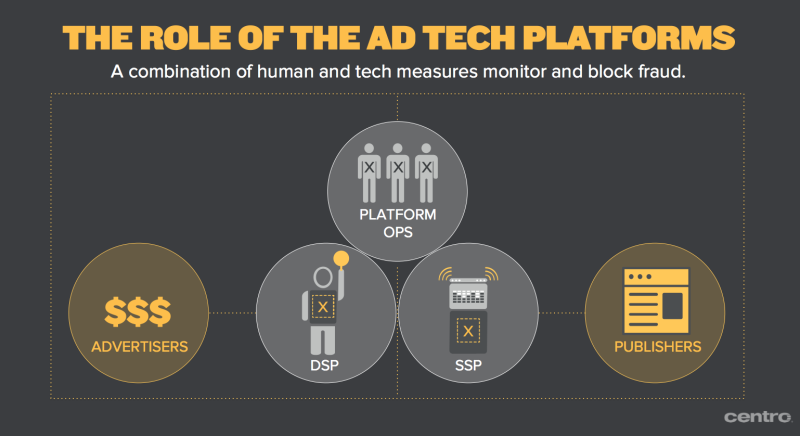Who Should Be Responsible For Stopping Programmatic Ad Fraud?
- Fahad H

- Mar 3, 2016
- 5 min read

In the first two installments of this ad fraud series, we examined what ad fraud looks like and discussed the reasons why ad fraud exists. In this third installment, we look at the various participants in the supply chain, and determine who should be responsible for stopping ad fraud.
The programmatic ad ecosystem is very compartmentalized in nature. There are sell-side technologies and buy-side technologies, each serving their own constituents.
But ad fraud impacts all participants, and it is in everyone’s long-term interest that it be stamped out. While most individual players have been reluctant to even discuss its existence — for fear of being the one who opened Pandora’s box — it’s time for the players to step up and own their portion of responsibility. What does this mean?
The current “solution” is that each participant puts pressure on the company that is one step upstream from them. So, for example, a brand demands clean inventory from their agency. The agency expects their DSP (demand-side platform) partners to have clean inventory. The DSPs demand that ad exchanges do a better job of passing through clean inventory. And so on.
But this is just another form of hot potato, and it does nothing to root out the problem.
But let’s start at the source. Let’s look at how fraud enters the programmatic ecosystem and see how responsibility flows.
The Role Of Publishers
Fake traffic has become a commodity. There’s malware for generating it and brokers who sell it. Some companies pay for it intentionally, some accidentally, and some prefer not to ask where their traffic comes from. –Bloomberg Businessweek, “ How Much Of Your Audience Is Fake? ”
Publishers are ground zero for where fraud takes place. As the quote above suggests, there are differing levels of intent and complicity from publishers.
Some engage in fraudulent traffic acquisition intentionally; others do so accidentally — usually under the auspices of “audience development.”
Whatever the reasoning, the fact of the matter is that it exists, and publishers must be accountable for any fraudulent impressions that find their way into their inventory.
In this day and age, prudent publishers should proactively monitor their own inventory using the many tools available to them (e.g., Integral Ad Science and Pixalate). This allows publishers to ensure that they are not unintentional vehicles for fraud and signals to the other participants that their inventory is clean.
The Role Of Supply-Side Platforms
Once we move from the publishers to the ad tech players, things get a little tricky. This is where many people get tripped up, so bear with me as I explain.
Back in the day, we had ad networks. Ad networks worked with both publishers and advertisers.
By doing so, they were able to manually vet each participant in the ad network. They were also accountable to both the supply and the demand sides.

Ad tech players act as agents for each side of the marketplace.
In the post-ad network programmatic ecosystem, different technology companies separate supply and demand. Publishers (the supply side) use SSPs (supply-side platforms) as their agent to sell their inventory. Advertisers (the demand side) use DSPs as their agent to buy that inventory.
So, as we move down the supply chain from publishers, we have to start by looking at SSPs.
This is a key point: Fraudulent publishers cannot take part in the programmatic ecosystem without an SSP enabling them with the technology to participate.
Now, this raises an obvious question: Why would an SSP allow fraudulent inventory on their platform?
There are a few possible answers:
• The SSP may not question the upstream traffic sources of its publishers. In other words, they may play ignorant by taking a hands-off approach with their customers.
• The SSP might well know about the practice but turn a blind eye on purpose. Again, this goes back to our last article on misaligned incentives.
• The SSP may simply not know. Fraudsters have been known to go to great lengths to hide their tracks, including bundling their fraudulent sites with legitimate sites (essentially using them as Trojan horses).
The bottom line is that none of these are acceptable. While an SSP is an agent to the sell-side, I posit that it nonetheless owes a duty to the customers who purchase its goods.
It may be difficult to identify fraud, but not attempting to do so is a dereliction of an SSP’s duty to its buy-side partners. We need to enforce higher standards on the supply side; they are the first line of defense against fraud, so they bear the most responsibility.
The Role Of Demand-Side Platforms
If fraudulent impressions are proliferating through exchanges, the responsibility to combat fraud then necessarily falls on DSPs. While many are up to the challenge, the reality is that it’s a never-ending game of whack-a-mole.
There are literally hundreds of thousands of sites that come through the exchanges. As a result, it’s virtually impossible to check them all by hand.
Even if it were possible with a massive team, it would negate the efficiency gains of programmatic advertising in the first place. On top of that, SSPs are generally protective of their relationships with publishers (rightly so), making it difficult for DSPs to get information or ask questions directly of publishers.
That said, there are things that can be done. For my company’s DSP, we use a combination of human checks mixed with technical measures to monitor and block fraud on our platform.
In addition, all our DSP traffic is monitored using third-party fraud-detection technology. This produces rich reporting on questionable traffic that we block (pre-bid) from future campaigns.
Our team routinely reviews this data and blocks sources with excessive non-human traffic. There are other tools and processes we use, but I don’t want to disclose these for fear of tipping off fraudsters.
Unfortunately, not all DSPs go to these lengths to fight fraud, which passes the problem along to marketers. And without the support of all of its SSP partners, fighting fraud from the DSP vantage point is a Herculean task.
Ultimately, everyone has to do their part to fight fraud: DSPs, SSPs, and even marketers. But, it shouldn’t be reaching marketers if everyone else is doing their job to tackle fraud.
In A Perfect World
In a perfect world, fraudulent inventory would never make its way into the marketplace, because each participant would do their part and act as a necessary check on fraud. This would entail:
• Publishers ensuring that ads are served to real humans by monitoring traffic sources.
• Suppliers, such as ad exchanges (or SSPs), vetting all publishers on their platforms.
• Ad-buying platforms (DSPs) proactively monitoring and blocking low-quality inventory.
• Marketers utilizing their own tools as a last line of defense.
Unfortunately, we don’t live in a perfect world, and not all participants are carrying their respective load. In practice, this means that it is incumbent on marketers to take matters into their own hands to protect themselves from fraud.
In the next — and final installment — of this series, we will examine the ways marketers can protect themselves against fraud.








Comments